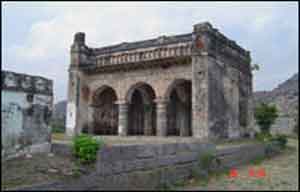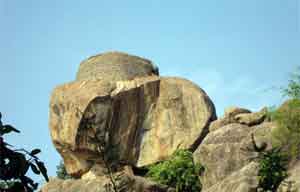
Important places outside the fort
Venkataramana Temple
Venkataramana temple is situated near the "Gateway of Pondicherry" in the South, faces East with high gopura. This temple was built by Muthialu Nayaka in 1540 A.D. - 1550 A.D. This temple is the place of worship till date. In this temple there are also deities of Devi, Aandaal and Narasima. There are two prakaras, Kalyana Mandapa,Urchava Mandapa and Yaga Sala Mandapa with pillars.

Sad-Ullah Khan Mosque
On the left side of the first entrance of Rajagiri fort there is a path which faces East. Here, Sad-Ullah Khan's mosque is located. The Archaeological Survey of India conserves and preserves the mosque. This mosque is the place worship to Muslims during their rule. This mosque was built between 1717 and 1715 A.D.

Venugopala Swami Temple
It is situated to the West of the granary. The idols seen here are in broken condition. The southern gateway of the temple has doors, made of wood. This gateway is called the 'Gateway of Thiruchirapalli'. This opens to the southern region of the country.

The Architecture of Jumma Mosque
In 17th Century A.D. Sad-ad-ullah khan ruled Gingee during his rule he built a mosque near the pathway to Chakkarai Kulam, Chettikulam and Sri Anjaneya temple.
The entrance of Sd-ad-ullah khan's Jumma mosque was built with lime mortar and with arch and ornamental decorations. Even though the entrance is with measures of 2.50 meter. length, 2.10 meter. breath and 4 meter. height, it is in ruined condition.
The next one is rectangular shaped granite stage with measures of 12.25 meter. length, 9.65 meter breadth and 1 meter height on this stage, a mosque (worship place) facing towards east, has been constructed with mortar and bricks in the west side. It's measures are 12.25 meter. length 9.65 meter. height. But this mosque is in destructive condition.
On the Opposite side to this mosque, there is one burial ground/cemetery where dead bodies were buried. This cemetery architectures are preserved from further damages by the Department of Archaeology safely.

Kamalakanni Amman Temple
Next to the pond and mandapa Kamalakanni Amman (Durga) temple is located. Even now this deity is worshipped. In front of the temple, there is a slaughter Dais of 1.30 mtrs. wideth. During festival time, a buffalo is slaughtered on this dais. There is a standing Vishnu picture of multi colors of Nayaka age (17th Century A.D.) on a vertical rock at the back of the temple. Vishnu has sangu and chakara in his hands. There is a female deity on the right of Vishnu with a flower in her left hand in katharimuka pose.
Bhudevi who is on the lfet of Thirumal has neelothpala flower in her right hand. Bhudevis is tied breasts are covered are covered with kuccha pantha. The base of the three figures is extrapolated to form like blades of a rising sun. Vishnu has been garlanded. At the tip, it has been painted in the form of Thazhambu flower.
This is similar to that of Leepakshi paintings in Andhra pradesh. All the three figures are below a decorated shamiana. Above this, there is a baby picture which worships Vishnu. In a corner, there are hands of devas showering flowers. The size of this picture is 5' X 5' to the left, there is a dancing figure 1 1/2 feet length. The face and the left hand are destroyed. Only two right hands are left.
Yet another figure is present on the right side of Vishnu, which is fully ruined. The face seems to be of Narasimha. The legs are in the yoga posture. It is decorated above the figure of Narasimha.

Pond and Mandapa
A pond is on the left side of the path in front of Kamalakanni amman temple with natural steps. It is now ruined. There is a mandapam made of granite on pond. In olden days Lord Ranganatha is taken in a procession from Singapuram village, brought here, decorated, put on a float for the circumbulation of the pond. Hence the name Ranganathar mandapam.

Anjaneya Temple
Chakkaraikulam and Chettykulam are situated on the Southside of Gingee fort. At the end of these ponds, there is an Anjaneya on the rock with dimensions of 2 meter breadth and 2.30 meter height. Later a temple was created with few mandapam around this Anjaneya sculpture. In front of the temple only stone pillars are found.

Prisoners' well
To the west of the Hanuman temple there is a Prisoners' well on a large rock. It is a natural rock over they built a circular wall of 38 meters in circumference, 12 meters in inner circumference and 4 meters in depth with bricks. The interior part looks spacious and deep and it is built in such a way that no one can climb and look out. In those days they pushed the condemned prisoners into the well and so they died of thirst and hunger.

Temple of Seven Maidens
It is situated to the West of the granary. The idols seen here are in broken condition. The southern gateway of the temple has doors, made of wood. This gateway is called the 'Gateway of Thiruchirapalli'. This opens to the southern region of the country.

Temples of Lord shiva and Amman Shrine
The temple of Lord Shiva is situated here. In the temple, there is a Shiva Lingam in the sanctum sanctorum. In addition to this, there is a Goddess temple in the East where the front mandapam

Gate way of Pondicherry
When we move across the pathway in the East, we can see the gate with mandapa facing Pondicherry. So this gateway got its name as "Gateway of Pondicherry" In front of Pondicherry Gate entrance at Eastern side (North facing gate entrance of top portion The Persian inscription is found and its translate in English) is given below.
"'The Exalted Khan Saddatulah Khan, upon whom be multiplied the blessing of Haider, Captured the fort of Gingee by the favors of incomparable almighty Ghulam Ali discovered date for it. Islam Expelled infidelity 1125 HIJRI (1712 A.D. - 1713 A.D.)"

Gateway of Vellore
The Gate is situated in the North and the Mandapa faces Vellore. So it is named as "Gateway of Vellore"